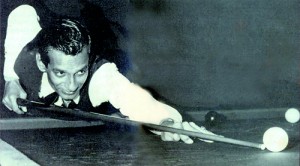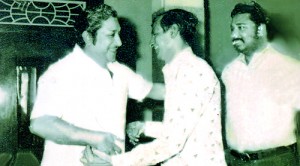Reliving a Lankan moment of glory
Sri Lankans regardless of gender or class differences got the first taste of a World Cup victory exactly 40 years ago, when the late billiards maestro Mohamed Junaid Mohamed (M.J.M.) Lafir, had the honour of winning the World Amateur Billiards Championship in Bombay in December 1973. The country was astounded 23 years later with the national cricket team led by Arjuna Ranatunga winning the ICC Cricket World Cup in 1996 and with that feat Lafir’s achievement was overshadowed.

Billiards maestro M.J.M. Lafir, who won the 1973 World Cup
But, to be apparent, each of these world titles has its own glamour and uniqueness. The reasons are obvious as to why Sri Lankans still live with the memories of the ICC Cricket World Cup win in 1996. Lafir’s achievement was similarly adored for 23 years, since it was brought to Sri Lankan shores on December 5, 1973 after a marathon tournament of 21 days but the silverware ‘was a mountain of gold’ according to some of those who came across that era. As cue sport enthusiasts and players of present era in Sri Lanka noiselessly celebrate the 40th anniversary of Lafir’s great feat for others it has become a bygone occurrence.
Lafir, a man who had gone through the bitter hardships of life had many friends. With conditions in India, doing all the homework prior to the big event and continued playing and practices, Lafir’s ambition was clearly envisioned by his friends around him. By the time Lafir won the World Cup at the Bombay Cricket Club, he had recorded 27 breaks of over 500, including one of 879, which lead him to make a new world record break, during a phase of six months.
“I am one of those among living to have played alongside Lafir. His playing style was a feast to watch and sometimes Lafir’s opponents used to forget that they were playing against him. His art of taming the cue on the green baize was really amazing. It’s a pity that Sri Lanka could not get the best of his knowledge,” laments veteran Robin Haniff, a former player and a comrade of Lafir during his active days.
It is an unknown fact that Lafir took the trouble to arrange practice games with Haniff at the Moors’ Islamic Cultural Home (MICH) in Dematagoda, where both were playing members. In one such occurrence, the two players duly started the game after Lafir had an early lunch on a Sunday.

was even admired by the late South Indian actor Sivaji Ganesan. - Pic courtesy national player O. Sirajedeen
“I cued off and when Lafir got the frame I asked him if he would excuse me for lunch as I live in the proximity of the MICH. There was a good crowd watching and he told me that I could go ahead. I went home had a quick shower and ate my lunch thinking that he would be done with the frame. But I was wrong; he was still playing and he went on to play for the next hour before scoring 859 points,” Haniff recalled.
Despite his terrific form over the six months in the run-up for the World Cup Lafir’s progress was somewhat hampered after his income source, as a horse racing commission agent, was banned by the then government. In his own words or in horse racing term, Lafir was quoted as saying his profession was ‘gone for a walk’ by his close friends.
Realizing Lafir’s potential his friends took the trouble to fund the maestro while his overseas friends too took up to the task by sending funds. In the January 1974 issue of ‘Snooker Scene’ the evergreen Clive Everton, the editor of the publication termed Lafir’s feat as follows.
“Mohammed Lafir, who learnt to play Billiards on his family dining table using a broomstick for a cue, marbles for balls, a sarong for a cloth and a cycle tube for cusions, won the World Amateur Billiards Championship at the Cricket Club of India, Bombay, winning all his nine matches and making a new world record break of 859”.
Everton, a five time Welsh Billiards Champion, a billiards player who represented Wales at many world championships and a well known billiards and snooker commentator and correspondent, termed Lafir’s record breaking feat as a tortoise beating a hare.
“A thousand looked very much on but after 49 minutes, 47 seconds the break came to an end when an attempted pot red in the middle from the spot end, just caught the jaw, position having been lost and the object-white offering only a pot or a four shot”.
Prior to winning his top prize in 1973, Lafir emerged the World Amateur Billiards Championship runner-up twice, in Colombo in 1967 and in London in 1969. He also reached the semi-final in the World Snooker Championship in 1970 in Scotland while finishing fourth in World Billiards Championship in 1971 in Malta. By the time of his demise in April 1981 at the age of 52, Lafir had won the National Snooker Championship 17 times and the National Billiards Championship 16 times, a record that stood until 2009. Besides these feats Lafir has won the All-India Billiards Championship once and the All-India Snooker Championship eight times.
Prasanna Pushpakumara, a national list billiards and snooker player and a former tournament secretary of the Billiards and Snooker Association of Sri Lanka (BSASL), one of the enthusiasts of Lafir and a great follower of the maestro, affirms that the current breed of players and the administrators could learn a heap from the champion.
“There are significant lessons that we could fetch from Lafir’s life as a player and more importantly from his personal life. I was never privileged to see him but of what I have gathered and heard, he was a great example for a humble human being. This made him a well respected and strong player, besides his commitment and natural talent. These are the facts we are missing these days. If we really are keen in giving the great man the due honour, what we should do is act boldly and work genuinely for the betterment of the sport, not market his achievement and live by it,” Pushpakumara, depressed by the current state of billiards and snooker said.



